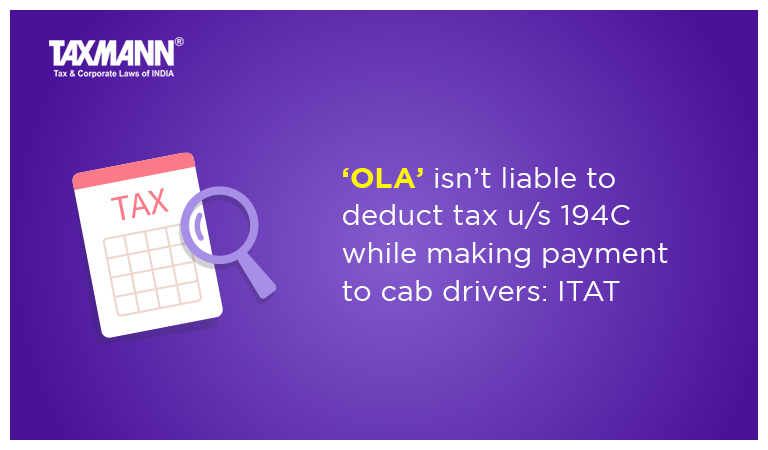‘OLA’ isn’t liable to deduct tax u/s 194C while making payment to cab drivers: ITAT
- Blog|News|Income Tax|
- 2 Min Read
- By Taxmann
- |
- Last Updated on 24 September, 2022
Case Details: ANI Technologies (P.) Ltd. v. DCIT (TDS) - [2022] 142 taxmann.com 442 (Chandigarh-Trib.)
Judiciary and Counsel Details
-
- Sudhanshu Srivastava, Judicial Member & Vikram Singh Yadav, Accountant Member
- Deepak Chopra, Anmol Anand, Deepak Aggarwal & Ms Priya Tandon, Advs. for the Appellant.
- Vivek Nangia, CIT, DR for the Respondent.
Facts of the Case
Assessee was a leading technology service provider in the cab-hailing market in India. It has established mobility for the Indian masses and it provides internet and mobile technology platform for cab hailing by the passengers. The Assessee operates under the brand name “OLA”.
The assessee had made payments to the cab drivers for “carrying out work” relating to the carriage of passengers. The Assessing Officer (AO) treated the assessee as assessee-in-default as it failed to deduct tax at source (TDS) under section 194C while making the payments to the cab drivers.
On appeal, the CIT(A) upheld the view of AO. Aggrieved-assessee filed the instant appeal before the Tribunal.
ITAT Held
The Tribunal held that prima facie the case of the assessee was covered in its favour by the order of the Mumbai Bench of the ITAT in the case of Uber India Systems (P.) Ltd. [2021] 125 taxmann.com 185 (Mumbai – Trib.). The Mumbai Tribunal had held that section 194C was not applicable on such ayments as were collected from customers and were forwarded by drivers and further the transportation services were provided by the drivers to the users.
In the instant case, much like Uber B.V./ Uber India, the assessee only provides the mobile app “OLA” on which the Driver lists himself/herself to provide transportation services to the Rider.
The terms of the agreements of the assessee clearly bring out that it is the Driver that will provide transportation service to the Rider and not the assessee. Even the invoices raised on the Rider demarcate this distinction. Therefore, the person responsible under section 204(iii) to invoke the provisions of section 194C is the Rider and not assessee.
The Rider is entitled to use the assessee’s platform or avail transportation services only for personal use, as per the User Terms and Subscription Agreement respectively. Since such personal use by the Rider is exempt from liability to deduct tax, as per section 194C(4) no liability can be fastened on the assessee.
Disclaimer: The content/information published on the website is only for general information of the user and shall not be construed as legal advice. While the Taxmann has exercised reasonable efforts to ensure the veracity of information/content published, Taxmann shall be under no liability in any manner whatsoever for incorrect information, if any.

Taxmann Publications has a dedicated in-house Research & Editorial Team. This team consists of a team of Chartered Accountants, Company Secretaries, and Lawyers. This team works under the guidance and supervision of editor-in-chief Mr Rakesh Bhargava.
The Research and Editorial Team is responsible for developing reliable and accurate content for the readers. The team follows the six-sigma approach to achieve the benchmark of zero error in its publications and research platforms. The team ensures that the following publication guidelines are thoroughly followed while developing the content:
- The statutory material is obtained only from the authorized and reliable sources
- All the latest developments in the judicial and legislative fields are covered
- Prepare the analytical write-ups on current, controversial, and important issues to help the readers to understand the concept and its implications
- Every content published by Taxmann is complete, accurate and lucid
- All evidence-based statements are supported with proper reference to Section, Circular No., Notification No. or citations
- The golden rules of grammar, style and consistency are thoroughly followed
- Font and size that’s easy to read and remain consistent across all imprint and digital publications are applied








 CA | CS | CMA
CA | CS | CMA


